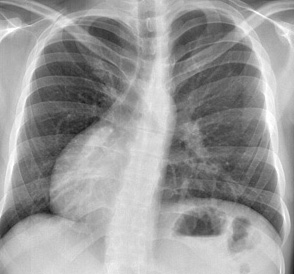Dextrocardia: Difference between revisions
No edit summary |
No edit summary |
||
| Line 1: | Line 1: | ||
'''For the WikiPatient page for this topic, click [[Dextrocardia (patient information)|here]]''' | '''For the WikiPatient page for this topic, click [[Dextrocardia (patient information)|here]]''' | ||
{{Infobox_Disease | | {{Infobox_Disease | | ||
Name = Dextrocardia | | Name = Dextrocardia | | ||
| Line 18: | Line 15: | ||
MeshNumber = C14.240.400.280 | | MeshNumber = C14.240.400.280 | | ||
}} | }} | ||
{{Dextrocardia}} | |||
''' | {{CMG}}; '''Associate Editors-In-Chief:''' [[Priyamvada Singh|Priyamvada Singh, MBBS]] [[mailto:psingh@perfuse.org]]; {{CZ}}; [[User:KeriShafer|Keri Shafer, M.D.]] [mailto:kshafer@bidmc.harvard.edu]; Claudia Hochberg, M.D.; '''Assistant Editor-In-Chief:''' [[Kristin Feeney|Kristin Feeney, B.S.]] [[mailto:kfeeney@perfuse.org]] | ||
== | ==[[Type page name here overview|Overview]]== | ||
== | ==[[Type page name here pathophysiology|Pathophysiology]]== | ||
[[ | ==[[Type page name here epidemiology and demographics|Epidemiology and demographics]]== | ||
== | ==[[Type page name here natural history|Natural history, Complications, and Prognosis]]== | ||
== | ==[[Type page name here causes|Causes]]== | ||
==[[Type page name here differential diagnosis|Differentiating Type page name here from other Disorders]]== | |||
==Diagnosis== | |||
[[Type page name here history and symptoms|History and Symptoms]] | [[Type page name here physical examination|Physical Examination]] | [[Type page name here laboratory tests|Laboratory Tests]] | [[Type page name here electrocardiogram | Electrocardiogram]] | [[Type page name here chest x ray|Chest X Ray]] | [[Type page name here MRI|MRI]] | [[Type page name here CT|CT]] | [[Type page name here echocardiography|Echocardiography]] | [[Type page name here other imaging findings|Other Imaging Findings]] | [[Type page name here other diagnostic studies|Other Diagnostic Studies]] | |||
== | ==Treatment== | ||
'''Medical:''' [[Type page name here medical therapy|Medical Therapy]] | |||
'''Surgical:''' [[Type page name here surgery|Surgery]] | |||
[[Type page name here primary prevention|Primary Prevention]] | [[Type page name here secondary prevention|Secondary Prevention]] | [[Type page name here cost-effectiveness of therapy|Cost-Effectiveness of Therapy]] | [[Type page name here future or investigational therapies|Future or Investigational Therapies]] | |||
==References== | ==References== | ||
| Line 101: | Line 45: | ||
==Additional resources== | ==Additional resources== | ||
* [http://www.rch.org.au/cardiology/health-info.cfm?doc_id=3538 Overview at rch.org.au] | * [http://www.rch.org.au/cardiology/health-info.cfm?doc_id=3538 Overview at rch.org.au] | ||
{{Congenital malformations and deformations of circulatory system}} | {{Congenital malformations and deformations of circulatory system}} | ||
[[Category:Cardiology]] | [[Category:Cardiology]] | ||
Revision as of 12:53, 10 August 2011
For the WikiPatient page for this topic, click here
| Dextrocardia | ||
 | ||
|---|---|---|
| ICD-10 | Q24.0 | |
| ICD-9 | 746.87 | |
| DiseasesDB | 3617 | |
| MeSH | C14.240.400.280 | |
|
Dextrocardia Microchapters |
|
Diagnosis |
|---|
|
Treatment |
|
Dextrocardia On the Web |
|
American Roentgen Ray Society Images of Dextrocardia |
Editor-In-Chief: C. Michael Gibson, M.S., M.D. [1]; Associate Editors-In-Chief: Priyamvada Singh, MBBS [[2]]; Cafer Zorkun, M.D., Ph.D. [3]; Keri Shafer, M.D. [4]; Claudia Hochberg, M.D.; Assistant Editor-In-Chief: Kristin Feeney, B.S. [[5]]
Overview
Pathophysiology
Epidemiology and demographics
Natural history, Complications, and Prognosis
Causes
Differentiating Type page name here from other Disorders
Diagnosis
History and Symptoms | Physical Examination | Laboratory Tests | Electrocardiogram | Chest X Ray | MRI | CT | Echocardiography | Other Imaging Findings | Other Diagnostic Studies
Treatment
Medical: Medical Therapy
Surgical: Surgery
Primary Prevention | Secondary Prevention | Cost-Effectiveness of Therapy | Future or Investigational Therapies